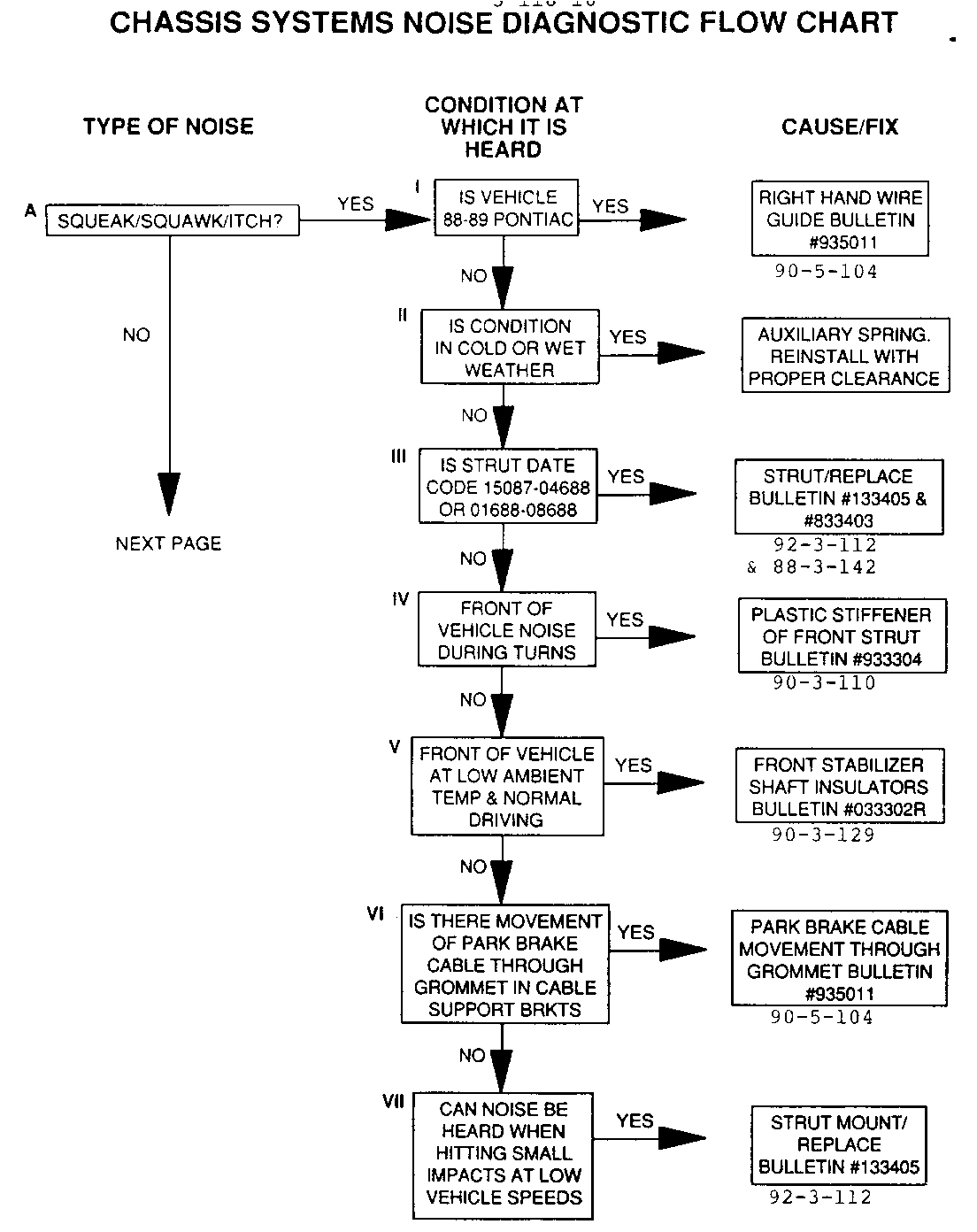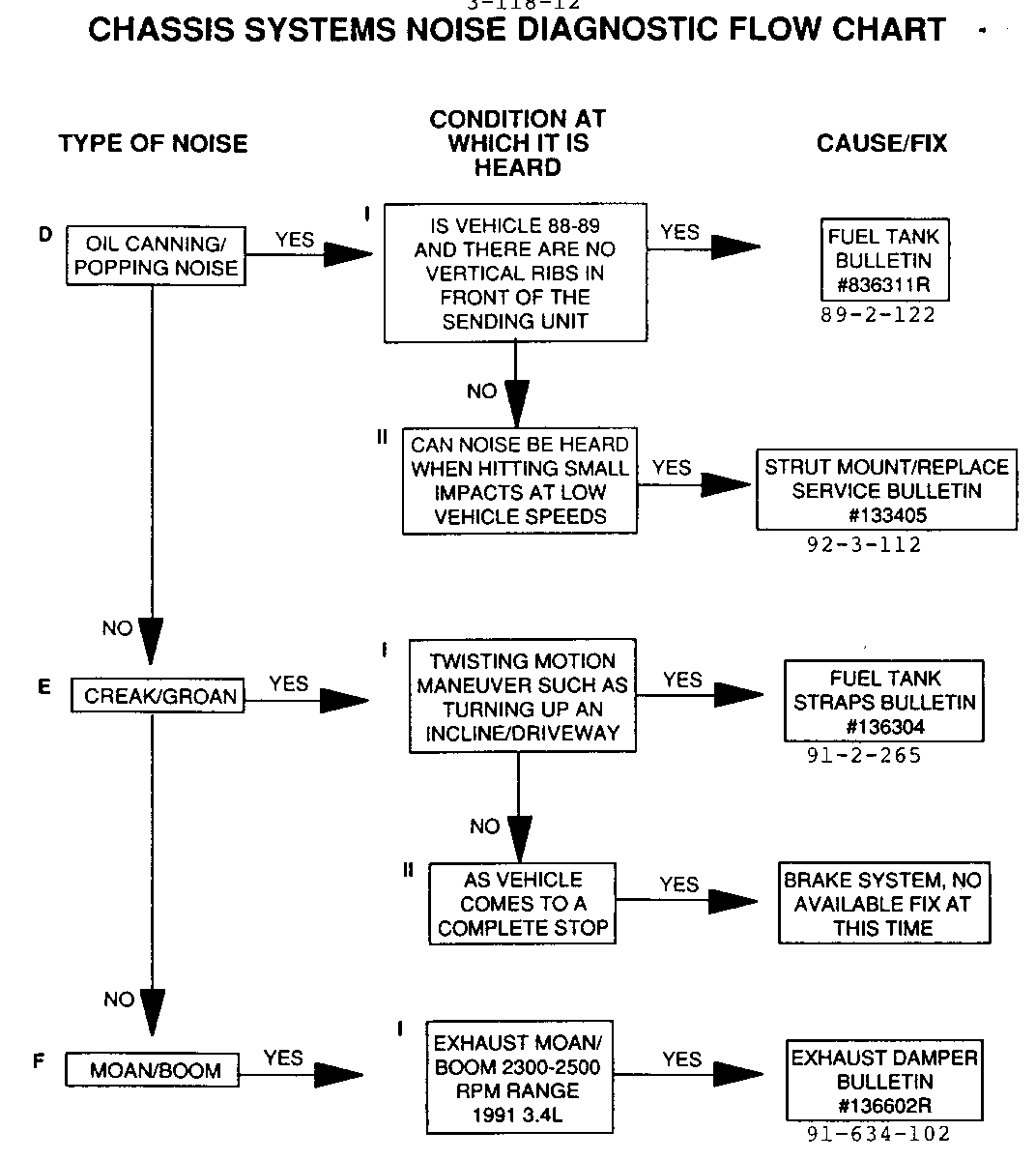CHASSIS SYSTEM RELATED NOISE (DIAGNOSIS AND SUMMARY)

SUBJECT: CHASSIS SYSTEMS RELATED UNDERBODY NOISE DIAGNOSIS AND SUMMARY
VEHICLES AFFECTED: 1988-92 "W" CAR
Some 1988-92 W-cars may exhibit various noises emanating from the underbody of the vehicle that may be caused by a variety of conditions related to the various chassis systems.
It is the intent of this bulletin to summarize prior issued bulletins and to provide insight into other conditions that have been noted. To aid and insure proper diagnosing of customer noise comments, a diagnostic flow chart is provided at the end of this bulletin.
When prior published bulletins are referenced, they should be utilized to insure proper service procedures are followed.
(A) SQUEAK/SQUAWK/ITCHING NOISE -------------------------------- Condition: I ------------- Squeaking/squawking during normal suspension/vehicle operation (1988-89 Pontiac Only)
Cause: Right hand park brake cable moving through non-required wire guide installed by assembly plant.
Correction: Remove non-required guide (Product Service Bulletin # 90-5-104).
Condition: II -------------- Squawking during normal vehicle operation and most prevalent in cold or wet weather (1988-89 vehicles).
Cause: Auxiliary spring rubbing against edge of spring mounting bracket.
Correction: Remove auxiliary spring per procedure outlined in Service Manual and reinstall with clearance to edge of mounting bracket.
Condition: III ------------- Squeak and/or clunk noted during normal suspension movement (Early 1988 vehicles Only).
Cause: Defective strut assemblies with date codes 15087-04688 (clunk) and 01688-08688 (squeak).
Correction:
Replace strut dampers with the effected date codes. Any other struts that are suspected of being noisy should be bench checked per the procedure outlined in the diagnosis section of the Service Manual. Replace only those struts which exhibit excessive noise during the bench test. (Reference Product Service Bulletin # 88-3-142).
Condition: IV ------------- Squeaking/Itching from front of vehicle during a turning maneuver on 1990 vehicles assembled prior to breakpoints below:
Suspension VIN Carline Level Breakpoint ------- ---------- ---------- Chevrolet All Levels L9153753 (Oshawa 1)
L1137308 (Oshawa 2)
Buick Base L1402187
Oldsmobile All Levels LD322460
Note: Not applicable to Pontiac Vehicles.
Cause: Movement between strut mount cushion plastic stiffener, strut rod and/or strut mount cushion.
Correction: Remove the plastic stiffeners from both of the front strut mount cushions (Reference Product Service Bulletin #90-3-110).
Condition: V ----------- Squawk from front of vehicle at low ambient temperatures and normal operation on 1988-90 vehicles assembled prior to breakpoints below:
VIN Carline Breakpoint ------- ---------- Chevrolet L9279163 (Oshawa 1)
L1201451 (Oshawa 2)
Oldsmobile LD395552
Pontiac LF296738
Buick L1407852
Cause: Stabilizer shaft rotating in the power control arm stabilizer shaft insulators.
Correction: Install new high compression lower control arm stabilizer shaft insulators, P/N 10152155 (Reference Product Service Bulletin # 90-3-129).
Condition: VI ------------- Squeaking during normal suspension/vehicle operation (1988-90 vehicles).
Cause: Park brake cable movement through grommet in cable support brackets.
Correction: Apply lubricant to cables in area of grommets (Reference Product Service Bulletin # 90-5-104).
Condition: VII -------------- Thumping/squawk noise from rear of vehicle, and most apparent when operated at low speeds over irregular road surfaces.
Cause: A load spike caused by the strut jounce bumper system transmitting noise through the body strut tower structure.
Correction: Replace both rear strut jounce bumper assemblies with new assemblies contained in service unit, P/N 22063945 (Reference Product Service Bulletin #92-3-112).
(B) THUD/CLUNK NOISE Condition: I --------------------- ------------ Thud/Clunk noise from rear of vehicle most apparent after a harsh/sharp road input such as a chuck-hole/ speed bump (1988-91 vehicles with auxiliary springs).
Cause: Auxiliary rear spring lower attaching bracket not in full contact with rear spindle rod.
Correction: Insure auxiliary rear springs lower brackets are properly seated on spindle rods (Reference Product Service Bulletin #91-3-130).
Condition: II ------------- Clunk noted during normal suspension/vehicle movements (1988-90 vehicles)
Cause: Exhaust system contacting rear stabilizer shaft.
Correction:
Inspect exhaust system and stabilizer shaft for witness marks due to metal-to-metal contact. Align exhaust system to provide adequate clearance if interference condition is noted.
Condition: III -------------- Thud noted during extended suspension movement. Condition most apparent when vehicle is turning up parking ramp/driveway or driven over deep chuck-hole or speed bump (1988 and early 1989 vehicles).
Cause: Rear struts extend to their maximum travel. Not detrimental to struts but associated noise may be cause of annoyance.
Correction:
Replacement of both rear struts and spring plates with interim 1989 components provides additional 10 mm of travel. Component replacement will reduce the potential for occurrence of this condition but may not eliminate it completely and is inherent to suspension design.
Condition: IV ------------- Thud/clunk from rear of vehicle after a harsh/sharp road input such as a chuck-hole/speed bump.
Cause: Spindle rod bushing(s) loose in the spindle rod. Spindle rod cross section appears somewhat collapsed at open ends.
Correction:
Replace spindle rods.
Base Suspension Up Level Suspension --------------- ------------------- P/N 10062855 (Front) P/N 10062857 (Front) P/N 10152146 (Rear) P/N 10152147 (Rear)
(C) RATTLE NOISE
Condition: I ------------ Metallic rattling during normal vehicle operation or engine run-up in neutral (1988-90 vehicles).
Cause: Loose clinch nuts in either exhaust intermediate pipe or underbody hanger brackets.
Correction:
Install washer P/N 11500367 between hanger and either or both the underbody and pipe brackets.
Condition: II ------------- Metallic rattling noted during engine run-up in neutral or normal suspension/vehicle operation. (1988-90 vehicles).
Cause: Loose exhaust system heat shields.
Correction:
Inspect and tighten loose exhaust system heat shield fasteners insuring sufficient clearance is maintained.
Condition: III
Dull rattling noted during normal suspension/vehicle operation (1988-90 vehicles)
Cause: Park brake cable grommets not properly installed in underbody retaining brackets.
Correction:
Insure both underbody brackets are not distorted and install cable grommets (Reference Product Service Bulletin 90-5-104).
Condition: IV ------------- Metallic rattles noted during normal vehicle operation (1991 Pontiac SE and GT coupes with "Aero Performance Package", RPO B4U)
Cause: Exhaust tailpipe extensions contact rear bumper valance panel/heat shield.
Correction: Install new tailpipe extensions, P/Ns 10199291 (LH) and 10199292 (RH). (Reference Product Service Bulletin #91-2-260).
Condition: V ------------ Light hammering/rattle type noise from front of vehicle after a cold start at low ambient temperatures on 1988 vehicles assembled prior to VIN breakpoints below:
VIN Carline Breakpoint ------- ---------- Buick - J1452620
Oldsmobile - JD314355
Pontiac - JF216305
Cause: Pressure pulsations in the fuel system generated by fuel injector operation, resulting in hydraulic hammering in chassis fuel pipes.
Correction: Install new underhood fuel return hose and stand-pipe assembly, P/N 10114735, (Reference Product Service Bulletin # 88-628-126).
(D) OIL CANNING/POPPING NOISE ----------------------------- Condition: I ------------ Oil canning/popping noise noted during normal vehicle operation (1988-89 vehicles).
VIN Carline Breakpoint ------- ---------- Pontiac KF206642 Oldsmobile KD303396 Buick K1418999
Cause: Normal internal fuel tank pressure results in oil canning noise.
Correction: Replace fuel tank with new service tank, P/N 12516117, that has additional ribbing on upper and lower tank sections (Reference Product Service Bulletin # 89-2-122).
Condition: II ------------- Thumping/squawk noise from rear of vehicle, and most apparent when operated at low speeds over irregular road surfaces.
Cause: A load spike caused by the strut jounce bumper system transmitting noise through the body strut tower structure.
Correction: Replace both rear strut jounce bumper assemblies with new assemblies contained in service unit, P/N 22063945 (Reference Product Service Bulletin #92-3-112).
(E) CREAK/GROAN NOISE --------------------- Condition: I Creak/groan or, in severe instances, a clunk/thud noise during a vehicle twisting motion maneuver such as turning up a steep incline/driveway (1989-91 vehicles).
VIN Carline Breakpoint ------- ---------- Oldsmobile MD332722 Pontiac MF235111 Buick M1848929 Chevrolet M9170499 (Oshawa 1) M1124665 (Oshawa 2)
Correction: 1989-91 vehicles prior to above VIN breakpoints.
Install new fuel tank straps, P/N 10199250 and strap spacers, P/N 10192675 (Reference Product Service Bulletin # 91-2-260).
1991 after VIN breakpoints:
Install new fuel tank straps, P/N 10199250 (Reference Product Service Bulletin # 91-2-260).
(F) MOAN/BOOM NOISE -------------------- Condition: I Exhaust Moan/Boom 2300-2500 RPM range on 1991 vehicles with 3.4L engines (RPO LQ1) assembled prior to VIN breakpoints below: VIN Carline Breakpoint ------- ---------- Chevrolet M9192950 Pontiac MF262219 Oldsmobile MD360170
Cause: Exhaust system excited by engine exhaust pulse induced vibration.
Correction: Install exhaust damper, P/N 10199232 (Reference Product Service Bulletin # 91-634-102).



General Motors bulletins are intended for use by professional technicians, not a "do-it-yourselfer". They are written to inform those technicians of conditions that may occur on some vehicles, or to provide information that could assist in the proper service of a vehicle. Properly trained technicians have the equipment, tools, safety instructions and know-how to do a job properly and safely. If a condition is described, do not assume that the bulletin applies to your vehicle, or that your vehicle will have that condition. See a General Motors dealer servicing your brand of General Motors vehicle for information on whether your vehicle may benefit from the information.
